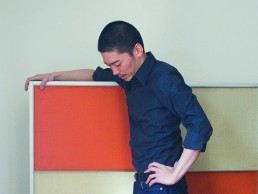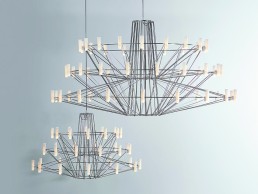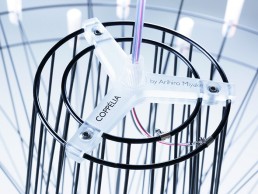
Arihiro Miyake
Japanese designer Arihiro Miyake discusses the importance of technology, communication and awareness in working with eccentric Dutch brand moooi to create the geometric Coppélia chandelier.
Miyake never enjoyed studying but felt drawn to more creative disciplines, as he tells darc: “When I was a kid, I was not really interested in studying. I enjoyed art and I was good at it. I liked making things and when I found the subject of product design, I thought ‘this could be my job for life.’” Throughout his education, Miyake studied at Kobe Design University and then, as he discovered more about the work of European designers he saw in magazines, he moved to Finland to study at the University of Art and Design in Helsinki. Here, he completed his masters degree and gained experience wherever he could, soaking up the talent of his motivated and inspiring classmates.
“At school, I was surrounded by talented people and I believe they made me who I am today,” he says.
The young designer took a part-time job at university and invested all of his money in developing prototypes of his own products. This was his favourite stage of a project, where he would get to see the first prototype model in his hands, after countless drawings on paper and computers. “Seeing the prototype is the moment you know how far the design is from the result you are aiming for,” says Miyake. Each year, he presented his prototypes at SaloneSatellite in Milan, part of Salone del Mobile furniture fair that’s dedicated to the work of young designers.
During his studies in Finland, Miyake worked for multidisciplinary designers including Finnish architect and product designer Ikka Suppanen. Suppanen played an important role in helping Miyake to develop his own understanding of spatial design as well as product design, before he went on to set up his own design firm, Studio Arihiro Miyake. Based in Helsinki, his team now works across product, spatial and concept design, always wanting to create new experiences by taking a fresh look at the things we live with.

Miyake’s interest in lighting design stems from his excitement for the LED revolution, a technological advancement, which he feels lucky to be part of. “Before, we could only design shades for light bulbs, but now we can actually design the light source itself. This creates so many possibilities and so much freedom in design, and this kind of major change doesn’t happen so often in the industry.”
With the launch of his Coppelia chandelier for moooi, Miyake received international recognition, and he sees this design as the one that made his career. Working with the eccentric Dutch brand brings a lot of freedom, as they encourage their designers to be spontaneous without constraining them with a brief.
“The unique point of working with moooi is that everything starts with hand-drawn sketches,” says Miyake. “They look at sketches before any further development and when moooi sees something interesting, all the developments start.
“The idea of Coppelia began as a modern interpretation of the classic chandelier, one that could only work with LED technology. The design is very much about the structure. Each of the LEDs is powered through the steel frame itself, without any additional wires. The complex spoke-like structure of the light ensures that different parts of the frame carrying positive and negative currents never touch and only come together at each LED light source.
The stainless steel frame is very thin and comes in either a natural polished chrome or black satin finish. It comes in two different sizes; the larger version has 54 LEDs and the small one has 36. When the light turns on, the LEDs shine so brightly that the frame just seems to sit in the background, giving the appearance of little floating points of light. The result is a contemporary, geometric chandelier that looks weightless and elegant in its suspension.


“It’s not that different to the image I had originally drawn in my head,” reveals Miyake, “although it took a long time to create a functional wire frame that achieved the aesthetic balance as well. In fact, I spent one whole summer doing just that – no beach, no tan! I just kept drawing patterns on the computer to find the most beautiful and intelligent design.”
He named the chandelier after the famous French Coppelia ballet, because the form reminded him of a pirouetting ballerina.
Miyake admits humbly: “I don’t know what people see in my design. For me, the idea is the most important thing. I always start with an idea, which is my reason for designing something. So the form, the appearance, can be led by the reason too. This is what I want to share with people who use my products.”
The Coppelia chandelier was Miyake’s second design for moooi, having created the Carat desk light for the Dutch brand in 2009. Moooi founders Marcel Wanders and Casper Vissers happened upon his stand at Salone and took interest in the little desk light which can be repositioned at various angles by turning the weighted polyhedron base.
Miyake recalls: “Marcel and Casper stopped by my stand and they were interested in my lamp. Moooi decided to put it into production the following year and they named it after me, the Miyake lamp.”
The lamp was not a major seller for moooi and is now out of production but the experience of developing that product with moooi allowed Miyake to establish a fruitful relationship with the brand. From then on, Miyake regularly shared his ideas for products with Wanders and Vissers, which he usually worked on at night with a sketch pad and a glass of wine.
“After the Miyake lamp, moooi was expecting more ideas from me,” says Miyake. “I was constantly making sketches and once in while, there’s a kind of moment where a few things connect and usually that becomes one of my designs.” The Coppelia chandelier is the result of one of those moments. Miyake has travelled the world with his chandelier, giving talks at moooi’s showroom during London Design Festival and developing video series across various platforms to tell the story of his design and final product.
Miyake tells darc how he enjoys the process of working with manufacturers who can help to develop his ideas further. With moooi, he relied on a close working relationship, using his own communication skills to discuss his ideas with the craftsmen who have a wealth of knowledge and technological understanding. This process gives him a great deal of satisfaction, personally and professionally, as objects that he created in his head become physical objects that can be useful and aesthetically pleasing to people.
Miyake works with light because he recognises its importance in enhancing the experience of a space with an incomparable quality. “We live half of the day without sunlight, so it’s very natural that lighting effects us so much. The experience of happiness is created by a combination of different senses. Good food is not enough at a restaurant. We need good company and a good atmosphere as well, right?”
Today his collection of projects also includes interiors such as Tooth Tooth, a famous restaurant in Tokyo as well as a popular bakery in Osaka, Japan. He also works with companies to develop brand identities, showing just how varied and vast his creative capabilities are. As well as this, the designer also now teaches at the University of Art and Design in Helsinki, and as an interior architect for the Japan Finland Design Association.
With this myriad of experience and interests, Miyake is a designer who applies intelligence and emotional awareness to his products, always aiming to strike the right balance between form and function by leading with the practical side. He keeps an open mind throughout his design process and humbly cherishes the expertise of those around him, allowing him to find the best possible outcome through a collaborative and iterative process.



